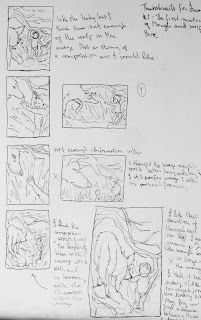Thumbnails- Wolf Den Scene
This is the scene in the very beginning of the book. It is a really important scene and is often illustrated by other artists in previous publications.
Shere Khan has attacked the 'man village' and tried to eat Mowgli, but he somehow escapes, 2 years old at the time, and stumbles into the wolf den. He comes out of the tall grass and runs into father wolf. A massive wolf thats very intimidating, or should be, to a 2 year old. But Mowgli just laughs.
"Directly infront of him, holding on by a low branch, stood a naked brown baby, who could just walk- as soft and as dimpled a little atom as ever came to a wolf's cave at night. He looked up at father's wolf cave and laughed."
I want to make the composition of this page reflect that quote. So, the readers eye can start at the top left corner and flow down, see the wolf, and then the baby. The wold is going to be massive and intimidating. the baby soft, as described, and the brach is going t oserve as an obstruction, hiding the entrance of the cave. I want to show the view from behind the wolf, it shows Mowgli intruding into their world, It also shows where Mowglis come from, and it seems like Mowgli emerges from the jungle, when in the book this is when Mowgli is introduced, so there is a parallel between the imagery and context. The tree, or low branch will serve to show a perspective of size of the wolf and the baby.











































